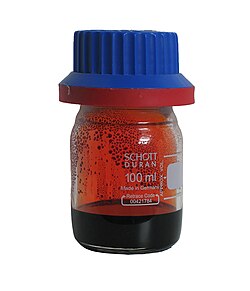Bromine
Bromine is rarer than about three-quarters of elements in the Earth's crust; however, the high solubility of bromide ion has caused its accumulation in the oceans, and commercially the element is easily extracted from brine pools, mostly in the United States, Israel and China. About 556,000 tonnes were produced in 2007, an amount similar to the far more abundant element magnesium.
At high temperatures, organobromine compounds are easily converted to free bromine atoms, a process which acts to terminate free radical chemical chain reactions. This makes such compounds useful fire retardants and this is bromine's primary industrial use, consuming more than half of world production of the element. The same property allows volatile organobromine compounds, under the action of sunlight, to form free bromine atoms in the atmosphere which are highly effective in ozone depletion. This unwanted side-effect has caused many common volatile brominated organics like methyl bromide, a pesticide that was formerly a large industrial bromine consumer, to be abandoned. Remaining uses of bromine compounds are in well-drilling fluids, as an intermediate in manufacture of organic chemicals, and in film photography.
Bromine has no essential function in mammals, though it is preferentially used over chlorine by one antiparasitic enzyme in the human immune system. Organobromides are needed and produced enzymatically from bromide by some lower life forms in the sea, particularly algae, and the ash of seaweed was one source of bromine's discovery. As a pharmaceutical, the simple bromide ion, Br–, has inhibitory effects on the central nervous system, and bromide salts were once a major medical sedative, before being replaced by shorter-acting drugs. They retain niche uses as antiepileptics.
Occurrence
The diatomic element Br2 does not occur naturally. Instead, bromine exists exclusively as bromide salts in diffuse amounts in crustal rock. Owing to leaching, bromide salts have accumulated in sea water at 65 part per million (ppm), which is less than chloride. Bromine may be economically recovered from bromide-rich brine wells and from the Dead Sea waters (up to 50,000 ppm). It exists in the Earth's crust at an average concentration of 0.4 ppm, making it the 62nd most abundant element. The bromine concentration in soils varies normally between 5 and 40 ppm, but some volcanic soils can contain up to 500 ppm. The concentration of bromine in the atmosphere is extremely low, at only a few ppt. A large number of organobromine compounds are found in small amounts in nature.
China's bromine reserves are located in the Shandong Province and Israel's bromine reserves are contained in the waters of the Dead Sea. The largest bromine reserve in the United States is located in Columbia County and Union County, Arkansas, U.S.
| Symbol | Br | |
| Atomic Number | 35 | |
| Atomic Weight | 79.904 | |
| Oxidation States | +1,+5,-1 | |
| Electronegativity, Pauling | 2.96 | |
| State at RT | Liquid, Nonmetal | |
| Melting Point, K | 265.9 | |
| Boiling Point, K | 331.9 |
Appearance and Characteristics
Harmful effects:
Bromine is poisonous and causes skin burns.
Characteristics:
- Pure bromine is diatomic, Br2.
- Bromine is the only nonmetallic element that is liquid at ordinary temperatures.
- It is a dense, reddish-brown liquid which evaporates easily at room temperature to a red vapor with a strong, chlorine-like odor.
- Bromine is less reactive than chlorine or fluorine but more reactive than iodine. It forms compounds with many elements and, like chlorine, acts as a bleaching agent.
Uses of Bromine
- Bromine compounds are used as pesticides, dyestuffs, water purification compounds, and as a flame-retardants in plastics.
- 1,2-dibromoethane is used as an anti-knock agent to raise the octane number of gasoline and allow engines to run more smoothly. This application has declined as a result of environmental legislation.
- Potassium bromide is used as a source of bromide ions for the manufacture of silver bromide for photographic film.
Vigorous reaction between bromine and aluminum.
How bromine is used to distinguish between saturated and unsaturated hydrocarbons.
Comparing the four halogens – fluorine, chlorine, iodine and bromine.
